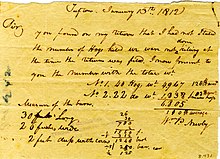History

The land for the farm was patented in two separate tracts of 150 acres each by Peter Jefferson in 1740 and 1755. [1] After he had the forest land cleared by enslaved people, he grew tobacco. [2]
When he died, the property passed to his son, Thomas Jefferson. [1] The farm was part of the original 5,000 acres that Jefferson owned. [3] It was a quarter farm, [4] located about 2 miles (3.2 km) from Monticello's main house gates. [3] The property was named for Lady Caroline Tufton (Tufton, Pembrokeshire § Name) by Martha Jefferson Randolph, Tufton was her schoolmate in Paris. [5] During Thomas Jefferson's lifetime, the farm's overseer lived in a clapboard-sheathed log cabin. [5]
Jefferson primarily raised wheat. [2] He also enjoyed novelties and experimented with plants from Africa and the Americas, rather than relying exclusively on cold season European vegetables. [6] Jefferson's farm raised tomatoes, okra, peppers, eggplant, squash that are now common in the American diet. [4] The farm provided corn, wheat, rye, and barley for the Monticello plantation. [1] [5] While he was president (1801–1809), Jefferson leased the farm to John Craven, who grew tobacco. [2]
Jefferson's grandson, Thomas Jefferson Randolph, managed the farm beginning in 1817. [1] That year, Randolph added a stone wing to the log cabin. [5] [a] After January 1, 1818, Randolph leased Tufton Farm with its 31 enslaved farmer workers and stock. [7] In 1826, following Jefferson's death, Randolph moved to Edge Hill. [5] By 1833, Thomas P. Macon owned the farm and he built a four square stone house in front of and attached to the brick addition of the overseer's house. [5] [b] Macon is believed to have grown wheat when he owned the farm. [2]
The log cabin portion of the overseer's house was torn down about 1949. A brick terrace was built between the main house and Randolph's stone addition, the latter of which became a carpentry workshop. The farm was owned by Charles Granquist by 1984. [5]
